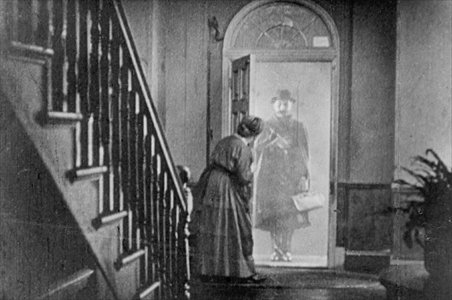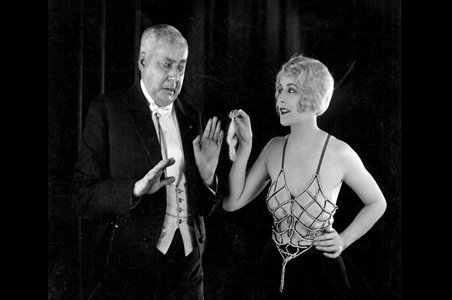Silent suspense
In an interview that Alfred Hitchcock gave to French New Wave director François Truffaut in 1966, Hitchcock told Truffaut a story: there are two Scottish men on a train. One man asks the other: "What do you think is in that package up there on the baggage rack?" The other answers, "Oh, that's a MacGuffin." "What's a MacGuffin?" the first man asks. "Well," the other man says, "It's an apparatus for trapping lions in the Scottish Highlands." The first man responds, "But there are no lions in the Scottish Highlands." And the other one answers, "Well, then that is no MacGuffin!"
MacGuffin is a term popularized by the legendary auteur and is regarded as a signature technique that Hitchcock employed to tell a story.

A still from The Lodger
In Hitchcock's films, a MacGuffin refers to a plot device that often appears in the first act of a film, and can be an object, a person, or an abstract concept like money, power or love. It motivates the actions of the film's protagonist, but declines in importance as the film moves on. The MacGuffin is always unconsciously ignored or forgotten by the audience by the end of the story, as though it never existed.
From Hitchcock's earliest silent films like The Lodger and Blackmail, to his famous classics like The 39 Steps, Vertigo and Psycho, a MacGuffin existed in almost every one of his films. The MacGuffin is a customary device in many Hollywood movies, like the robot R2-D2 in the Star Wars series, the mineral unobtainium in Avatar or the notebook in the Martin Scorsese's Hugo.
"Hitchcock is not only a thriller director, but really, a brilliant magician, who likes and is very good at playing magic tricks, playing hide-and-seek with the audience," Robin Baker told the Global Times.
Baker is the head curator at the British Film Institute's National Archive, a non-profit film heritage organization based in London, which holds one of the largest film and television collections in the world.
Baker was in Shanghai recently to attend the ongoing 16th Shanghai International Film Festival (SIFF), which this year features a special retrospective of early works by the master of suspense.

A still from The Pleasure Garden
Restored worksNine of Hitchcock's rarely seen silent films, which he made early in his career from 1925 to 1929, are being screened at this year's SIFF. The recently restored works include Blackmail, The Lodger, The Ring, The Manxman, The Pleasure Garden, Champagne and Easy Virtue.
The special screenings were organized by the SIFF organizing committee, the Cultural and Education Section of the British Consulate-General and the Institute of World Film at Shanghai Normal University.
According to Baker, they will be the first complete screenings after a four-year restoration project, Hitchcock 9, by the BFI National Archive. "Even for the cultural events during last year's London Olympic Games, we only screened one of them, Blackmail."
On June 18, The Pleasure Garden, Hitchcock's first completed film, was shown at the New Hengshan Cinema on Hengshan Road. It received a warm response from local cinemagoers and many film critics praised the restoration efforts on their personal microblogs.
Baker told the Global Times after the screening about the difficult and complicated work involved in restoring the film. "We have five surviving copies in our archives. However, four were fragile silver nitrate prints and there appeared to be two different versions of the film. Therefore, our technicians reconstructed a consensus version that closely resembled Hitchcock's original edit and then spent several months gingerly scanning 20 reels of ancient nitrate film rolls," Baker said.
The first Hitchcock movie
"I was also surprised and amazed by this film," Baker added. "Many people, including Hitchcock himself, claimed that The Lodger was 'the first Hitchcock's movie,' because it featured the first Hitchcock murder. I believe that they ignored the importance and fascination of The Pleasure Garden."
Baker explained to us that although The Pleasure Garden can't be regarded as a real thriller, the opening scene contains many obsessions that would appear in later Hitchcock films. The classic example is the use of the spiral staircase, which became one of Hitchcock's signature images featured in almost all his films.
"I think the staircase for Hitchcock is a great opportunity to arrange his actors," Baker said. "They often look very thrilling, which makes you feel that it is a place of danger. The other great thing about a staircase is you can create different kinds of shadows, which is another important element in Hitchcock's films."

Robin Baker, head curator at the British Film Institute's National Archive Photos: Cai Xianmin/GT and courtesy of Shanghai International Film Festival
Belated recognition
Baker told the Global Times that, in fact, Hitchcock didn't receive wide acclaim for his silent films, probably because most of them were not like his classic thrillers still popular today.
However, "Hitchcock himself called silent films 'the purest form of cinema' and he even created a kind of false impression that made his audience feel like there is sound in his silent films," Baker said.
In The Lodger, Hitchcock put the camera under a glass plane to shoot a scene where the protagonist is walking upstairs from below his feet. "It makes you feel like you can hear the sound of the footsteps," Baker said. "For me, the great thing about Hitchcock is he is so inventive in the way he created shots and tricks.
"Hitchcock filmed lots of commercial works and he really knew how to promote himself, but at the same time, he is also a great and pure artist. It is still very difficult for many film directors today to do both," Baker said.